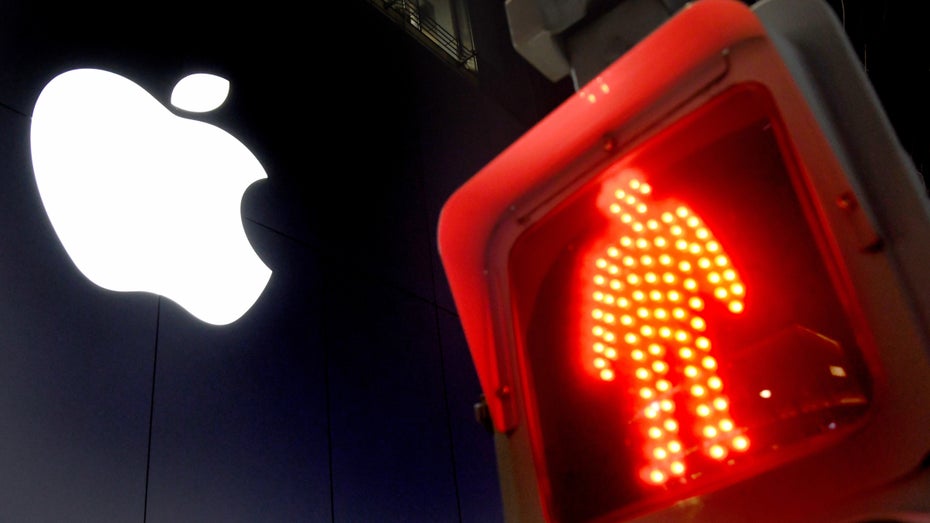
Corona scheint vorbei – zumindest in den Köpfen vieler Chefinnen und Chefs, die jetzt zum Rückzug ins Büro blasen. So auch Tim Cook, der seine Mitarbeitenden jüngst darauf einschwor, dass ab September zumindest in Teilen wieder auf dem Campus gearbeitet wird. An Montagen, Dienstagen und Donnerstagen sei Präsenzpflicht, schrieb er in der vergangenen Woche an sein Team. An den anderen beiden Tagen könne weiterhin zu Hause gearbeitet werden. Für Apple ist das ein großer Schritt, denn die Homeoffice-Mentalität war zuvor ziemlich restriktiv und physische Abwesenheit nicht gern gesehen. Jubel ist dennoch nicht ausgebrochen, wie The Verge jetzt aufgedeckt hat.
Mit agilem Recruiting die richtigen Talente finden und binden – in unserem Guide erfährst du, wie es geht!
Apple-Mitarbeiter wollen nicht zurück ins Büro

Homeoffice-Pläne von Tim Cook stoßen auf Widerstand. (Foto: dpa)
Laut dem Bericht wehren sich einige Teile der Belegschaft gegen die pauschale Rückbeorderung ins Büro. Ein interner Brief an Tim Cook und seinen Führungsstab fordert ein stärkeres Bekenntnis zur Heimarbeit ein. „Viele von uns haben das Gefühl, dass wir zwischen der Kombination aus Familie, Wohlbefinden sowie der Möglichkeit, unsere beste Arbeit abzuliefern einerseits und ein Teil von Apple zu sein andererseits wählen müssen“, heißt es in dem internen Brief. Laut The Verge hätten rund 80 Angestellte daran mitgeschrieben. Am vergangenen Freitag sei er firmenweit in der Belegschaft verschickt worden, um Mitstreiterinnen und Mitstreiter zu mobilisieren.
Auch interessant: Erste Firmen machen das Homeoffice zur neuen Arbeitsnormalität
Konkret fordern die Autorinnen und Autoren, dass die Entscheidung über Homeoffice oder nicht auf Ebene einzelner Teams getroffen werden solle und nicht allein aufgrund des Willens einiger weniger Top-Führungskräfte. Apple solle außerdem regelmäßige Umfragen in der Firma durchführen und auch im Offboarding gezielt danach fragen, inwiefern die Homeoffice-Regelung eine Rolle bei der Entscheidung gespielt habe, zu kündigen. Im vergangenen Jahr habe man sich nicht nur oft überhört gefühlt, sondern bisweilen sogar aktiv ignoriert, wenn vom Management behauptet wurde, dass das Team sich darauf freue, endlich wieder ins Büro nach Cupertino zu kommen. Gegenteilige Meinungen hätten kein Gehör gefunden. Das ist der komplette Brief.
Dear Tim and Executive Leadership,
Thank you for your thoughtful considerations on a hybrid approach to returning to office work, and for sharing it with all of us early this week. We appreciate your efforts in navigating what has been undeniably an incredibly difficult time for everyone around the world, and doing so for over one hundred thousand people. We are certain you have more plans than were shared on Wednesday, but are following Apple’s time-honored tradition of only announcing things when they are ready. However, we feel like the current policy is not sufficient in addressing many of our needs, so we want to take some time to explain ourselves.
This past year has been an unprecedented challenge for our company; we had to learn how to deliver the same quality of products and services that Apple is known for, all while working almost completely remotely. We did so, achieving another record-setting year. We found a way for everyone to support each other and succeed in a completely new way of working together — from locations we were able to choose at our own discretion (often at home).
However, we would like to take the opportunity to communicate a growing concern among our colleagues. That Apple’s remote/location-flexible work policy, and the communication around it, have already forced some of our colleagues to quit. Without the inclusivity that flexibility brings, many of us feel we have to choose between either a combination of our families, our well-being, and being empowered to do our best work, or being a part of Apple. This is a decision none of us take lightly, and a decision many would prefer not to have to make. These concerns are largely what prompted us to advocate for changes to these policies, and data collected will reflect those concerns.
Over the last year we often felt not just unheard, but at times actively ignored. Messages like, ‘we know many of you are eager to reconnect in person with your colleagues back in the office,’ with no messaging acknowledging that there are directly contradictory feelings amongst us feels dismissive and invalidating. Not only do many of us already feel well-connected with our colleagues worldwide, but better-connected now than ever. We’ve come to look forward to working as we are now, without the daily need to return to the office. It feels like there is a disconnect between how the executive team thinks about remote / location-flexible work and the lived experiences of many of Apple’s employees.
For many of us at Apple, we have succeeded not despite working from home, but in large part because of being able to work outside the office. The last year has felt like we have truly been able to do the best work of our lives for the first time, unconstrained by the challenges that daily commutes to offices and in-person co-located offices themselves inevitably impose; all while still being able to take better care of ourselves and the people around us.
Looking around the corner, we believe the future of work will be significantly more location and timezone flexible. In fact, we are already a distributed company with offices all over the world and across many different timezones. Apple’s organizational hierarchy lends itself towards offices that often follow the same structure, wherein people in the same organization are more likely to be co-located in an office. At the same time, we strongly encourage cross-functional, cross-organization collaboration, and our organization’s many horizontal teams reflect this. Such collaboration is widely celebrated across our organization, and arguably leads us to our best results — it’s one of the things that makes Apple, Apple. However, orgs are rarely co-located within walking distance, let alone in the same building, meaning our best collaboration has always required remote communication with teams in other offices and across timezones, since long before the pandemic. We encourage distributed work from our business partners, and we’ve been a remote-communication necessary company for some time, a vision of the future that Steve Jobs himself predicated in an interview from 1990. This may explain how mandatory out-of-office work enabled tearing down cross-functional communication barriers to deliver even better results.
Almost all of us have worked fully remote for over a year now, though the experience arguably would have been better less one pandemic. We have developed two major versions of all our operating systems, organized two full WWDCs, introduced numerous new products, transitioned to our own chipsets, and supported our customers with the same level of care as before. We have already piloted location-flexible work the last 15 months under much more extreme conditions and we were very successful in doing so, finding the following benefits of remote and location-flexible work for a large number of our colleagues:
- Diversity and Inclusion in Retention and Hiring
- Tearing Down Previously Existing Communication Barriers
- Better Work Life Balance
- Better Integration of Existing Remote / Location-Flexible Workers
- Reduced Spread of Pathogens
We ask for your support in enabling those who want to work remotely / in location-flexible ways to continue to do so, letting everyone figure out which work setup works best for them, their team, and their role — be it in one of our offices, from home, or a hybrid solution. We are living proof that there is no one-size-fits-all policy for people. For Inclusion and Diversity to work, we have to recognize how different we all are, and with those differences, come different needs and different ways to thrive. We feel that Apple has both the responsibility to recognize these differences, as well as the capability to fully embrace them. Officially enabling individual management chains and individual teams to make decisions that work best for their teams roles, individuals, and needs — and having that be the official stated policy rather than the rare individual exceptions — would alleviate the concerns and reservations many of us currently have.
We understand that inertia is real and that change is difficult to achieve. The pandemic forcing us to work from home has given us a unique opportunity. Most of the change has already happened, remote/location-flexible work is currently the “new normal,” we just need to make sure we make the best of it now. We believe that Apple has the ability to be a leader in this realm, not by declaring ‘everyone just work from home for forever,’ as some other companies have done, but by declaring an official broad paradigm policy, that allows individual leaders to make decisions that will enable their teams to do the best work of their lives. We strongly believe this is the ideal moment to “burn the boats” — to boldly declare ‘yes this can be done, and done successfully, because there is no other choice for the future.’
Es ist endlich Zeit, Diversity Management in deinem Unternehmen zu etablieren? Unser Guide zeigt dir, wie es geht! Jetzt lesen!
We have gathered some of our requests and action items to help continue the conversation and make sure everyone is heard.
- We are formally requesting that Apple considers remote and location-flexible work decisions to be as autonomous for a team to decide as are hiring decisions.
- We are formally requesting a company-wide recurring short survey with a clearly structured and transparent communication / feedback process at the company-wide level, organization-wide level, and team-wide level, covering topics listed below.
- We are formally requesting a question about employee churn due to remote work be added to exit interviews.
We are formally requesting a transparent, clear plan of action to accommodate disabilities via onsite, offsite, remote, hybrid, or otherwise location-flexible work. - We are formally requesting insight into the environmental impact of returning to onsite in-person work, and how permanent remote-and-location-flexibility could offset that impact.
- We have great respect for Apple and its leadership; we strongly believe in the Innovation and Thinking Differently (from “the way things have always been done” and “industry standards”) that are part of Apple’s DNA. We all wish to continue to “bleed six colors” at Apple itself and not elsewhere. At Apple, our most important resource, our soul, is our people, and we believe that ensuring we are all heard, represented, and validated is how we continue to defend and protect that precious sentiment.
This is not a petition, though it may resemble one. This is a plea: let’s work together to truly welcome everyone forward.
Apple hat branchenübliche Homeoffice-Regel
Dass Apple mit seinem Vorgehen jedoch keinesfalls alleinsteht, zeigt ein Blick in andere Tech-Konzerne: Google will ab September ebenfalls drei Tage in der Woche für Homeoffice freimachen. Auch Amazon, Netflix und Microsoft haben Hybridmodelle angekündigt. Lediglich Facebook schert aus und hat früh angekündigt, dass Mitarbeiterinnen und Mitarbeiter auch nach der Coronakrise weiter von zu Hause arbeiten dürften. Für Apple dürfte in Sachen Präsenzpflicht erheblich von Bedeutung sein, dass erst 2017 ein gigantischer Campus namens Apple Park fertiggestellt wurde. Das ringförmige Gebäude ist größer als das Pentagon und kann bis zu 12.000 Mitarbeitende fassen. Der milliardenschwere Bau wäre in der Form sonst wohl unnötig gewesen.
Auch interessant: Homeoffice, Präsenz oder Hybrid? So arbeiten die Dax-30 nach Corona weiter

